The first four installments of this series described preliminary items that must be understood to have a successful rapid intervention team (RIT) on the fireground. Posing the question “What is the true rapid intervention capability for your fire department?” and using National Fire Protection Association (NFPA) 1407, Standard for Training Fire Service Rapid Intervention Crews, as a guide, 18 points have been identified that can be used as minimum benchmarks in evaluating your department’s capabilities. The first 11 points were discussed in previous installments. The remaining seven points further deal with specific skills that should be essential for all firefighters functioning in the role of the RIT on the fireground.
Point 12 – Our department members have practiced and are skilled at moving firefighters over and around obstacles, including stairs.
Rescuing a downed firefighter can become extensive and may involve multiple decisions and choices as related to techniques that will be necessary in removing the firefighter from the hazard area. Often, these operations will take place under severe conditions that can include the inability to stand up due to high heat, limited or zero visibility and working in restricted or confined areas. The conditions present as well as the weight of the downed firefighter will dictate the methods used in removal. A 180-pound firefighter may weigh well over 300 pounds with turnout gear, self-contained breathing apparatus (SCBA) and water from firefighting operations absorbed into the gear.
Many of the difficulties experienced in moving a downed firefighter result from the gear that we wear. Limited “grab points,” bulkiness and entanglement points are just a few. Moving a downed firefighter is different from trying to move a civilian. We will not know how to mitigate these issues unless we have been exposed to them and have trained on overcoming them.
Point 13 – The members of our fire department have trained on and are proficient at enlarging existing openings in structures as well as forcible-entry techniques.
Conventional methods of removal may not be the quickest or easiest in all circumstances. Enlarging openings can create an entry or egress point to retrieve a downed firefighter. Making windows into doors is a very simple procedure on wood-frame structures and can be accomplished in less than 30 seconds with three cuts, provided firefighters are familiar with the technique and skilled in using basic tools (Figure 1). Enlarging openings also equals forcible entry – removal of objects such as doors, burglar bars, plywood covering windows or anything else that impedes the egress of firefighters must be able to be performed by RIT members.
Point 14 – Our firefighters are trained to remove trapped firefighters from constricted spaces as well as out windows.
When it comes to removing a downed firefighter, the most appropriate action to take due to conditions may be to use a window in the immediate area. A task such as this can prove to be very challenging if not trained on or practiced regularly. It is important to remember that the safest way to remove a downed firefighter from an upper level of a building is by using a staircase, if at all feasible, but firefighters may be forced to use windows for removal for a variety of reasons. The route taken into the structure may have been altered or changed during the course of operations by collapse; deteriorating fire conditions, an SCBA malfunction, air-supply issue and disorientation can all be factors that will dictate the need.
Can your department members successfully get a downed firefighter up and over a windowsill to facilitate removal? Numerous techniques have been developed to accomplish this. Extreme circumstances such as being faced with a 22-inch window 42 inches off the floor with only a 28-inch width of space to work within such as faced by Denver, CO, firefighters when Mark Langvardt was trapped is an example of what unbelievable challenges that can surface (Figure 2). If we train and can function under those types of circumstances, then we can apply the same principles or methods to be successful when all of those extreme conditions are not present.
Point 15 – Our firefighters are proficient in removing downed firefighters from upper levels using ladders and aerial devices.
Once out the window, we must be proficient on getting the firefighter down to the ground level. Trying to figure this out on the fireground when seconds count is not the place to try to figure out what way is best. This is a firefighting basic and is really no different than the skills that we should already possess that are necessary for removing civilians (Figure 3).
Are all of the members of your department trained and proficient in operating the aerial device that may be present on your fireground? This may seem extreme, but what happens if a “Mayday” occurs and that device is needed to perform rescue and the driver/operator is not readily available (Figure 4)?
Point 16 – The members of our department are skilled at various techniques to remove a firefighter from a sub-level or below-grade rescue situation.
According to studies conducted by the U.S. Fire Administration (USFA) and National Institute of Standards and Technology (NIST), more than 65% of collapse fatalities have occurred during fire attack operations.
The easiest method to effect a rescue in a situation such as a firefighter falling through the floor is to enter and extract the firefighter through an alternate entrance/exit to the space in which the person has fallen. This is more than likely not going to be possible or the most time efficient in all circumstances. When an alternate entrance/exit is not available, it becomes obvious that the quickest method for retrieval will be the area in the floor through which the firefighter fell. Raising the downed firefighter back up through the floor will require a great amount of weight to be lifted by a minimal number of rescuers. This may sometimes have to take place in an area that is confined or restricted.
The handcuff knot is one of the most important knots for every firefighter to know. Its greatest use is to pull firefighters to safety when trapped in below grade situations. Can every firefighter on your department tie this important knot (Figures 5 through 8)?
Many alternative techniques have been introduced and perfected to rescue a firefighter in a floor collapse (Figure 9). Different techniques should be trained on consistently to find out which ones work better or are more comfortable for the people performing them. A “Mayday” situation is not the time to try to learn them.
Point 17 – Our firefighters have the knowledge and skills to create anchor points and simple mechanical advantage systems.
Most firefighters are intimidated by the use of ropes, but it does not need to be that way. Techniques that are kept simple can be very useful for RIT or survival operations.
One of the most crucial steps involved when using rope for rapid intervention is the establishment of an adequate anchor. If one is not readily available, the firefighter must understand how to fabricate one (Figure 10). This can be difficult when a RIT is working in near-zero visibility. The major consideration when establishing an anchor is that it will support the weight of the load being placed on it.
The basic mechanical advantage systems incorporated into rapid intervention for the purposes of dragging, lifting or raising downed firefighters are meant to decrease the weight of a downed firefighter and making the task more efficient for the rescuers. These mechanical advantage systems are not meant to be set up in the same manner as with high-angle or vertical rescues that require additional expertise and equipment in regards to their safety and function. The rescue of a downed firefighter is not meant to be a technical rescue incident; time is of the essence – things must be kept simple and safe.
The concepts of mechanical advantage are easy to use. In fact, most RIT techniques are easier and quicker to perform with a proper pre-rigged 2:1 mechanical advantage system – even in a dark, smoke-filled environment.
The 2:1 mechanical advantage system is the simplest to set up and the easiest to understand. For these reasons, it is the preferred system to use for rapid intervention operations. Another advantage is that only a minimal amount of equipment is required to set up a 2:1 system (Figure 11).
Point 18 – Our firefighters know how to lower downed firefighters from upper levels using various techniques using basic equipment that includes the use of 2:1 mechanical advantage and high-point anchors.
Operating above the fire such as on the roof can be very risky. Not only can firefighters fall into attic spaces due to construction failure, but a RIT can be faced with firefighters becoming disabled due to medical problems as well (Figure 12). What techniques are your people familiar with to accomplish a removal such as this when an aerial device is not available or able to be used?
The concept of the 2:1 mechanical advantage previously mentioned can be applied to helping us remove a firefighter from an upper-level window or from a constricted space while keeping a minimum of rescuers in an immediately dangerous to life or health (IDLH) environment. Mechanical advantage with a high-point anchor can assist in lifting the downed firefighter over the windowsill or obstacle. The same system can be set up to be converted to control the descent of the downed firefighter (Figure 13).
Training is the key to successful RIT operations and staying out of trouble on the fireground. Knowing the basics needed for RIT operations can mean the difference between life and death. Any specific principles and techniques discussed in this series are not the only ones that exist. There are many other different variations that also work. The important thing is to train on them safely and know them well. The fireground is not the place to learn new skills.
The points brought forward to evaluate your department’s RIT capabilities can all be referenced to actual incidents that resulted in firefighter line-of-duty deaths. Do not ever forget the sacrifices made by the firefighters who have lost their lives in the line of duty. We honor them every time we respond to an alarm by learning from the lessons they have given us.
It is an honor for every firefighter to be part of the rich fire service traditions – losing our lives in the line of duty is not a tradition, however. Our attitude and culture is truly what leads us to be what we are. We must challenge the traditions and attitudes that lead us down the roads to failure. Today’s fire service operates and competes in a very volatile environment, both on and off the fireground. Are we ready for these challenges and do our members have the skills to overcome them?






